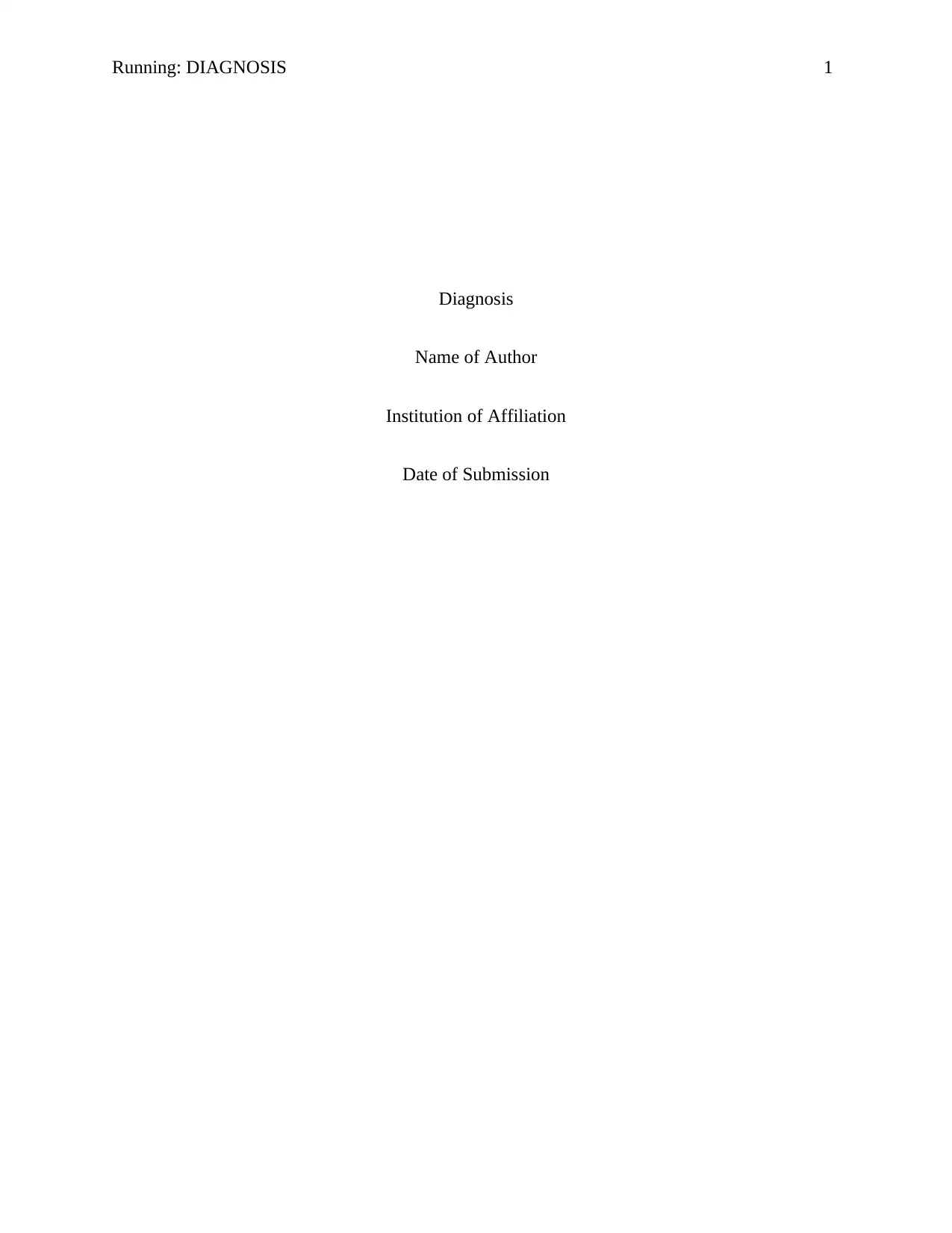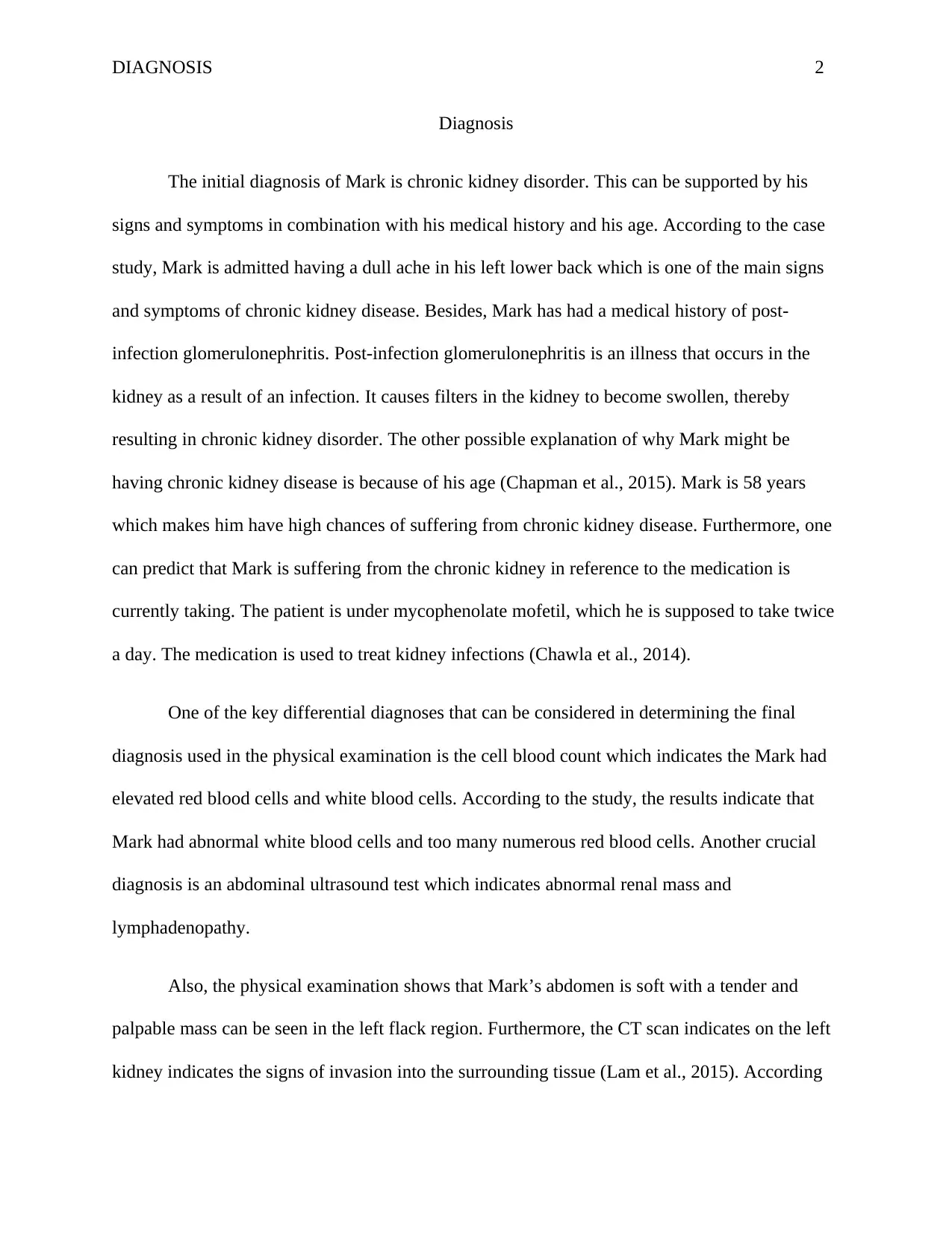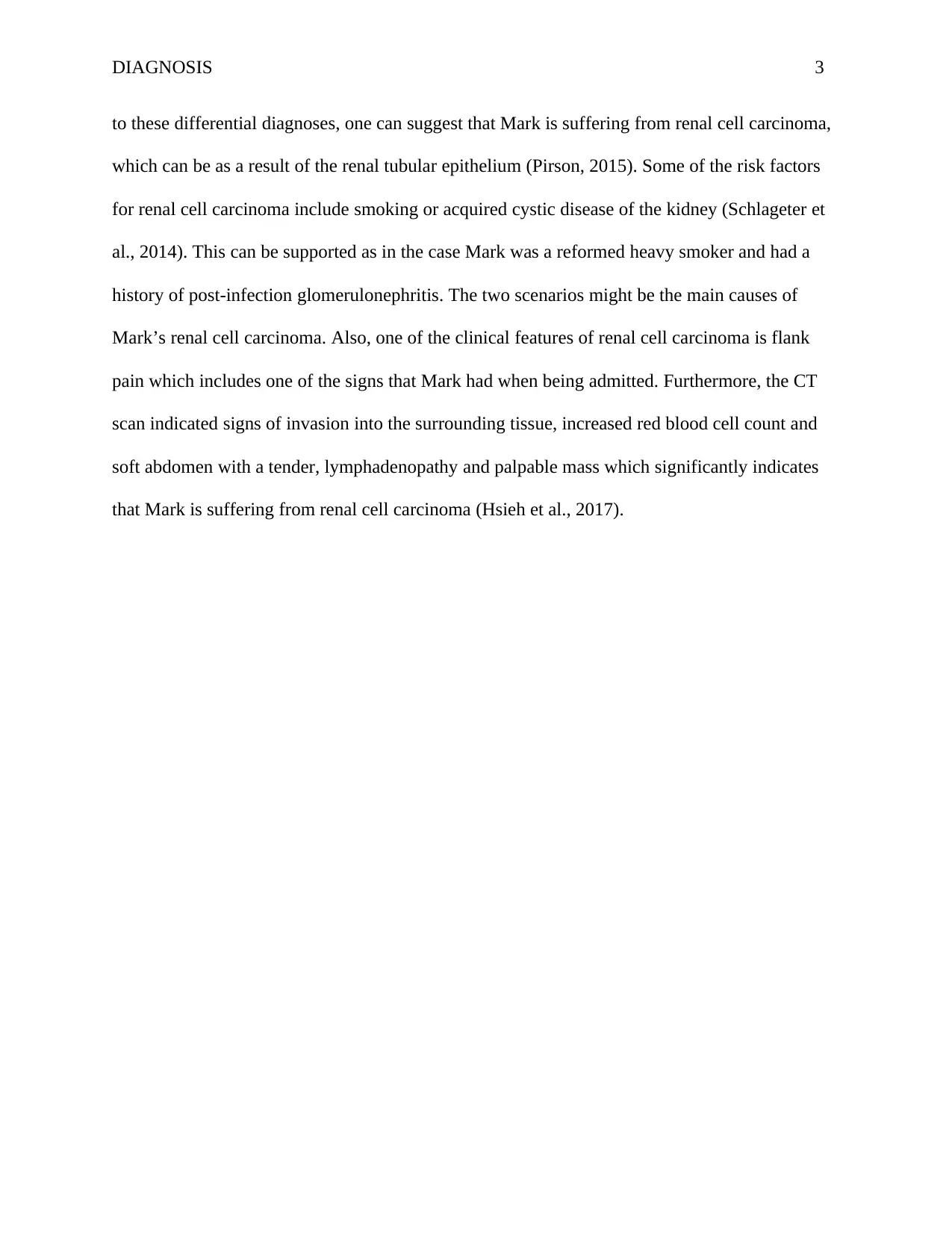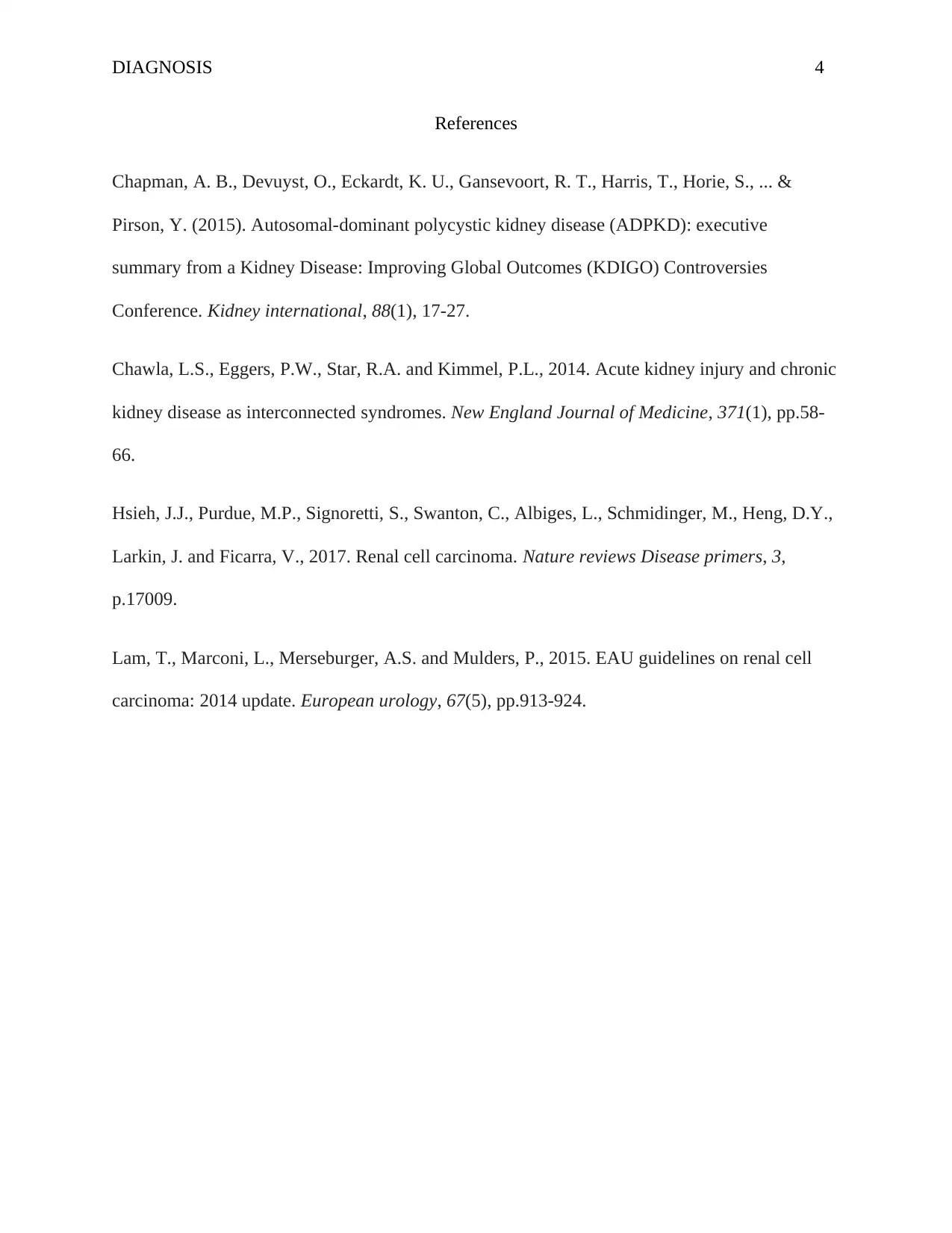Case Study on Diagnosis 2022
VerifiedAdded on 2022/10/09
|4
|734
|38
AI Summary
Contribute Materials
Your contribution can guide someone’s learning journey. Share your
documents today.

Running: DIAGNOSIS 1
Diagnosis
Name of Author
Institution of Affiliation
Date of Submission
Diagnosis
Name of Author
Institution of Affiliation
Date of Submission
Secure Best Marks with AI Grader
Need help grading? Try our AI Grader for instant feedback on your assignments.

DIAGNOSIS 2
Diagnosis
The initial diagnosis of Mark is chronic kidney disorder. This can be supported by his
signs and symptoms in combination with his medical history and his age. According to the case
study, Mark is admitted having a dull ache in his left lower back which is one of the main signs
and symptoms of chronic kidney disease. Besides, Mark has had a medical history of post-
infection glomerulonephritis. Post-infection glomerulonephritis is an illness that occurs in the
kidney as a result of an infection. It causes filters in the kidney to become swollen, thereby
resulting in chronic kidney disorder. The other possible explanation of why Mark might be
having chronic kidney disease is because of his age (Chapman et al., 2015). Mark is 58 years
which makes him have high chances of suffering from chronic kidney disease. Furthermore, one
can predict that Mark is suffering from the chronic kidney in reference to the medication is
currently taking. The patient is under mycophenolate mofetil, which he is supposed to take twice
a day. The medication is used to treat kidney infections (Chawla et al., 2014).
One of the key differential diagnoses that can be considered in determining the final
diagnosis used in the physical examination is the cell blood count which indicates the Mark had
elevated red blood cells and white blood cells. According to the study, the results indicate that
Mark had abnormal white blood cells and too many numerous red blood cells. Another crucial
diagnosis is an abdominal ultrasound test which indicates abnormal renal mass and
lymphadenopathy.
Also, the physical examination shows that Mark’s abdomen is soft with a tender and
palpable mass can be seen in the left flack region. Furthermore, the CT scan indicates on the left
kidney indicates the signs of invasion into the surrounding tissue (Lam et al., 2015). According
Diagnosis
The initial diagnosis of Mark is chronic kidney disorder. This can be supported by his
signs and symptoms in combination with his medical history and his age. According to the case
study, Mark is admitted having a dull ache in his left lower back which is one of the main signs
and symptoms of chronic kidney disease. Besides, Mark has had a medical history of post-
infection glomerulonephritis. Post-infection glomerulonephritis is an illness that occurs in the
kidney as a result of an infection. It causes filters in the kidney to become swollen, thereby
resulting in chronic kidney disorder. The other possible explanation of why Mark might be
having chronic kidney disease is because of his age (Chapman et al., 2015). Mark is 58 years
which makes him have high chances of suffering from chronic kidney disease. Furthermore, one
can predict that Mark is suffering from the chronic kidney in reference to the medication is
currently taking. The patient is under mycophenolate mofetil, which he is supposed to take twice
a day. The medication is used to treat kidney infections (Chawla et al., 2014).
One of the key differential diagnoses that can be considered in determining the final
diagnosis used in the physical examination is the cell blood count which indicates the Mark had
elevated red blood cells and white blood cells. According to the study, the results indicate that
Mark had abnormal white blood cells and too many numerous red blood cells. Another crucial
diagnosis is an abdominal ultrasound test which indicates abnormal renal mass and
lymphadenopathy.
Also, the physical examination shows that Mark’s abdomen is soft with a tender and
palpable mass can be seen in the left flack region. Furthermore, the CT scan indicates on the left
kidney indicates the signs of invasion into the surrounding tissue (Lam et al., 2015). According

DIAGNOSIS 3
to these differential diagnoses, one can suggest that Mark is suffering from renal cell carcinoma,
which can be as a result of the renal tubular epithelium (Pirson, 2015). Some of the risk factors
for renal cell carcinoma include smoking or acquired cystic disease of the kidney (Schlageter et
al., 2014). This can be supported as in the case Mark was a reformed heavy smoker and had a
history of post-infection glomerulonephritis. The two scenarios might be the main causes of
Mark’s renal cell carcinoma. Also, one of the clinical features of renal cell carcinoma is flank
pain which includes one of the signs that Mark had when being admitted. Furthermore, the CT
scan indicated signs of invasion into the surrounding tissue, increased red blood cell count and
soft abdomen with a tender, lymphadenopathy and palpable mass which significantly indicates
that Mark is suffering from renal cell carcinoma (Hsieh et al., 2017).
to these differential diagnoses, one can suggest that Mark is suffering from renal cell carcinoma,
which can be as a result of the renal tubular epithelium (Pirson, 2015). Some of the risk factors
for renal cell carcinoma include smoking or acquired cystic disease of the kidney (Schlageter et
al., 2014). This can be supported as in the case Mark was a reformed heavy smoker and had a
history of post-infection glomerulonephritis. The two scenarios might be the main causes of
Mark’s renal cell carcinoma. Also, one of the clinical features of renal cell carcinoma is flank
pain which includes one of the signs that Mark had when being admitted. Furthermore, the CT
scan indicated signs of invasion into the surrounding tissue, increased red blood cell count and
soft abdomen with a tender, lymphadenopathy and palpable mass which significantly indicates
that Mark is suffering from renal cell carcinoma (Hsieh et al., 2017).

DIAGNOSIS 4
References
Chapman, A. B., Devuyst, O., Eckardt, K. U., Gansevoort, R. T., Harris, T., Horie, S., ... &
Pirson, Y. (2015). Autosomal-dominant polycystic kidney disease (ADPKD): executive
summary from a Kidney Disease: Improving Global Outcomes (KDIGO) Controversies
Conference. Kidney international, 88(1), 17-27.
Chawla, L.S., Eggers, P.W., Star, R.A. and Kimmel, P.L., 2014. Acute kidney injury and chronic
kidney disease as interconnected syndromes. New England Journal of Medicine, 371(1), pp.58-
66.
Hsieh, J.J., Purdue, M.P., Signoretti, S., Swanton, C., Albiges, L., Schmidinger, M., Heng, D.Y.,
Larkin, J. and Ficarra, V., 2017. Renal cell carcinoma. Nature reviews Disease primers, 3,
p.17009.
Lam, T., Marconi, L., Merseburger, A.S. and Mulders, P., 2015. EAU guidelines on renal cell
carcinoma: 2014 update. European urology, 67(5), pp.913-924.
References
Chapman, A. B., Devuyst, O., Eckardt, K. U., Gansevoort, R. T., Harris, T., Horie, S., ... &
Pirson, Y. (2015). Autosomal-dominant polycystic kidney disease (ADPKD): executive
summary from a Kidney Disease: Improving Global Outcomes (KDIGO) Controversies
Conference. Kidney international, 88(1), 17-27.
Chawla, L.S., Eggers, P.W., Star, R.A. and Kimmel, P.L., 2014. Acute kidney injury and chronic
kidney disease as interconnected syndromes. New England Journal of Medicine, 371(1), pp.58-
66.
Hsieh, J.J., Purdue, M.P., Signoretti, S., Swanton, C., Albiges, L., Schmidinger, M., Heng, D.Y.,
Larkin, J. and Ficarra, V., 2017. Renal cell carcinoma. Nature reviews Disease primers, 3,
p.17009.
Lam, T., Marconi, L., Merseburger, A.S. and Mulders, P., 2015. EAU guidelines on renal cell
carcinoma: 2014 update. European urology, 67(5), pp.913-924.
1 out of 4
Related Documents
Your All-in-One AI-Powered Toolkit for Academic Success.
+13062052269
info@desklib.com
Available 24*7 on WhatsApp / Email
![[object Object]](/_next/static/media/star-bottom.7253800d.svg)
Unlock your academic potential
© 2024 | Zucol Services PVT LTD | All rights reserved.




